Systems inside cartridges: how engineers have expanded the capabilities of game consoles
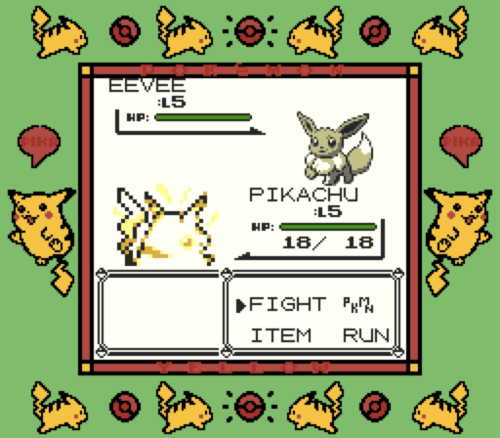
In the last article, we talked about three cartridges with an interesting feature: they had a connector into which other cartridges were inserted. Some other cartridges have developed this idea by allowing separate video game consoles to be connected to the connectors of their consoles. These were not ordinary hardware add-ons: they required their own cartridges that were incompatible with the main system.
Today we look at three very different "console inside cartridges" from three very different manufacturers. For the emergence of all three systems existed all the technological and strategic reasons, and they can tell us an interesting story. Let's start with the most mysterious system - the only one of the three that was unlicensed and was not made by the console creator.
Aladdin Deck Enhancer
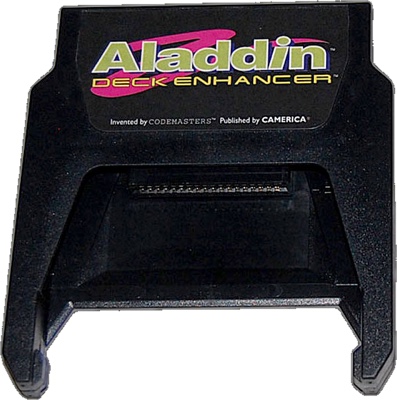 In the early 1990s, an impressive research and development laboratory must have been located in the office of Codemasters. Initially, the company was created to develop games for home computers Commodore, but a few years later opened the department to create unlicensed games and hardware add-ons to the Nintendo Entertainment System (NES). Perhaps the most famous product of the company, at least among console players, was the cheat device Game Genie 1 , but it turned out to be not the only example of unlicensed equipment for NES.
In the early 1990s, an impressive research and development laboratory must have been located in the office of Codemasters. Initially, the company was created to develop games for home computers Commodore, but a few years later opened the department to create unlicensed games and hardware add-ons to the Nintendo Entertainment System (NES). Perhaps the most famous product of the company, at least among console players, was the cheat device Game Genie 1 , but it turned out to be not the only example of unlicensed equipment for NES.One of the most amazing features of video game cartridges is their excellent versatility. In the process of developing technologies, cartridges became more powerful and complemented the capabilities of the consoles themselves. NES equipment was developed in the middle of 1983, and by the beginning of the 90s, he already needed all possible assistance. Later, various components appeared in NES cartridges, including RAM, controllers for switching memory banks, and special hardware mappers 2 .
')
Inside some of the cartridges for different games was the same equipment, the only difference was in the game data stored on ROM chips. Co-founder of Codemasters, Richard Darling, noticed this and he had a brilliant idea to create an add-on for NES, which allows making games easier and cheaper. The result of the implementation of this idea was the Aladdin Deck Enhancer, released in November 1992. Enhancer was a NES cartridge that contained everything but game data. It had a connector for connecting so-called “compact cartridges” (Compact Cartridge). These compact cartridges were supposed to be much smaller than regular NES cartridges and consist solely of game data recorded in ROM chips.
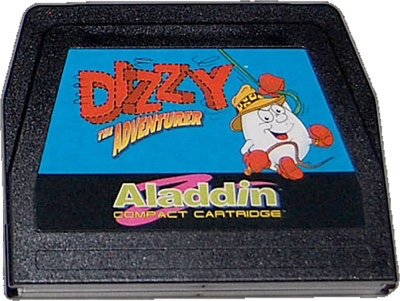
Dizzy the Adventurer on Compact Cartridge.
Codemasters hoped that Enhancer could become their own viable target platform for publishers interested in circumventing the official Nintendo licensing program and releasing their games on compact cartridges. Due to the smaller size and the fact that most of the electrical circuits required for conventional cartridges were already built directly into the Enhancer, compact cartridges could be sold much cheaper than regular licensed NES games. Considering that it was released after the NES (SuperNES) successor appeared on the market, it is obvious that Enhancer’s target audience was money-restricted buyers who were more interested in not new technologies, but simply games.
Unfortunately for Codemasters, the idea was never successful. Despite promises to release twenty-four games by the end of 1993, only seven games were released, and a lot of unsold devices remained dusty in warehouses for decades. Incredibly, a brand new, unopened Enhancer can be found on the Internet even twenty-five years after release 3 .
Super game boy
 Super Game Boy was an addition to the Super Nintendo Entertainment System (Super NES), providing an amazing opportunity to play games for the Game Boy. No larger than a conventional cartridge for Super NES, the Super Game Boy had a connector on the top edge into which standard Game Boy games could be inserted. By inserting a Game Boy cartridge and attaching the Super Game Boy to the console, for the first time players got a chance to play their favorite games on TV. Considering that the Game Boy was notorious for its grainy, blurry and dim screen, this seemed like a terrific improvement.
Super Game Boy was an addition to the Super Nintendo Entertainment System (Super NES), providing an amazing opportunity to play games for the Game Boy. No larger than a conventional cartridge for Super NES, the Super Game Boy had a connector on the top edge into which standard Game Boy games could be inserted. By inserting a Game Boy cartridge and attaching the Super Game Boy to the console, for the first time players got a chance to play their favorite games on TV. Considering that the Game Boy was notorious for its grainy, blurry and dim screen, this seemed like a terrific improvement.Modern players have become accustomed to the compatibility of old games with new systems, but for the 90s this idea was rather fresh 4 . The 90s consoles were not powerful enough for software emulation of other systems, so the Super Game Boy cartridge actually kept all the internal hardware of a conventional Game Boy. Despite the fact that at most he was just a Game Boy console in a cartridge, there were a few more tricks up his sleeve at the Super Game Boy.
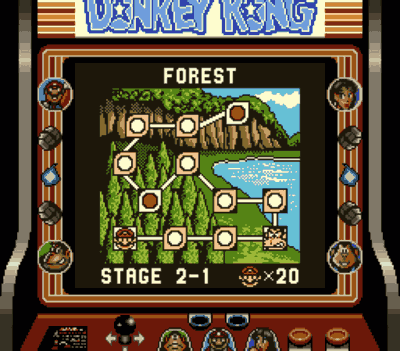
Donkey Kong on the Super Game Boy with a special frame.
Super NES games users had to play on large television screens, not on handheld device displays, so their resolution was higher than Game Boy games. This meant that when displaying a Game Boy game on the TV screen, its image had to be inserted into the frame. Players could choose from a variety of built-in decorative frames or create their own using virtual drawing tools. In addition, players could include colors in the game, replacing the Game Boy monochrome shades of colors with a self-selected palette. Some later games for the Game Boy were even released with their own built-in frames, and could use the hardware capabilities of the Super Game Boy to display more game colors 5 . Unfortunately for gamers, such improvements have not taken root, but those that were still released look amazing 6 .
The Super Game Boy was released in 1994, five years after the beginning of the Game Boy life cycle and three years after the release of the Super NES. In many ways, the release of the Super Game Boy was a very smart move. First, it has greatly expanded the library of games available for Super NES, instantly presenting access to three hundred additional games 7 . Secondly, he again drew attention to the Game Boy, which was losing popularity, and which at that time was beginning to seem outdated. Nintendo did not wait long to give Game Boy a second wind: the first Pokemon Pocket Monsters game was released in Japan in 1996, spawning a whole pop culture phenomenon, and by the end of the 1990s Nintendo released three additional versions of the Game Boy 8 console. In the end, the Game Boy line was one of the best-selling video game systems ever. 9
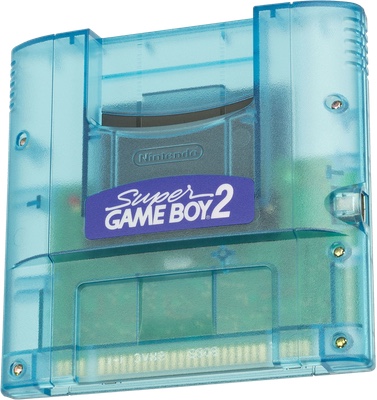 Super Game Boy 2 was released in Japan in 1998. He updated his style and corresponded to the fashion on the "transparent plastic" of the late 90s, and also made many improvements. The first version of the Super Game Boy did not exactly match the CPU speed of the original portable console, so the games ran 2.4% faster. In Super Game Boy 2, this bug was fixed; In addition, a Game Boy link cable connector was added to it, allowing two of them to play when there is a second console.
Super Game Boy 2 was released in Japan in 1998. He updated his style and corresponded to the fashion on the "transparent plastic" of the late 90s, and also made many improvements. The first version of the Super Game Boy did not exactly match the CPU speed of the original portable console, so the games ran 2.4% faster. In Super Game Boy 2, this bug was fixed; In addition, a Game Boy link cable connector was added to it, allowing two of them to play when there is a second console.In general, the Super Game Boy probably turned out to be the most successful “cartridge system”. Nintendo used the same idea in 2003 to release the Game Boy Player, which allowed playing GameCube games for the Game Boy Advance, Game Boy Color and the first Game Boy.
Sega 32x
 Of the three systems we are considering, the Sega 32X is less similar to the traditional game cartridge. The Sega Genesis 32X cartridge inserted into the cartridge adds significant graphic power to this gradually outdated system. It is not difficult to imagine that the designers of Sega tried to call the buyers of a powerful oil-jet engine with a turbocharger into buyers, especially considering the main target audience of the system - teenage boys 11 .
Of the three systems we are considering, the Sega 32X is less similar to the traditional game cartridge. The Sega Genesis 32X cartridge inserted into the cartridge adds significant graphic power to this gradually outdated system. It is not difficult to imagine that the designers of Sega tried to call the buyers of a powerful oil-jet engine with a turbocharger into buyers, especially considering the main target audience of the system - teenage boys 11 .Unlike the first two systems, the 32X was not a simple “turn on and play” device. Before connecting 32X players needed to install metal brackets inside Genesis. Then you had to connect 32X to a TV (not to Genesis), and then connect 32X to Genesis with a second video cable. Finally, the 32X had its own power source with a large transformer sticking out of the socket. After connecting the entire system, the back of the Genesis / 32X design was a chaos of wires 12 .
Released in 1994, the 32X appeared more than five years after the release of Genesis, which at that time was under increasing pressure from both Nintendo and other competitors with powerful next-gen consoles. Although the next-generation Sega’s own console was almost ready for release, it would be sold at the next-generation price, more than four times the current cost of the Sega Genesis 13 .
Sega hoped that there was a huge potential market for consumers who wanted to pay a relatively small amount to get a little closer to the next generation of games 14 , and it seemed that this strategy might work. However, the next day after the release of the Sega 32X in North America in Japan, a real next-generation console called the Saturn came out. Attempting to attract developers to the simultaneous support of two new systems was a difficult task, and consumer demand for the “half-step” to the next generation of consoles with each outgoing fell, because the current new generation was already very close. This put pressure on Sega and made Saturn release in North America earlier than planned, just six months after 32X. It was a disaster.
Nevertheless, it is easy for us to imagine a world in which 32X would be successful. If 32X were released a little earlier, or if Saturn were released a little later, then 32X would probably have time to reach popularity 15 . Even with the Genesis price, the 32X still cost half the price of the Saturn, and could offer a lot to the players in terms of hardware improvements. Unfortunately, instead of becoming the foundation of Sega's future success, the 32X foreshadowed Sega's gradual withdrawal from the console development market.
Supplement on Supplements
Cartridge connectors were intended for games, not for systems, but brave engineers still expanded the boundaries of the possible and created impressive devices based on them. The transition from cartridges to optical discs, and then to digital content download, meant that the time for the cartridges for the cartridges had come and gone.
Hardware additions are found in the modern history of video games - for example, remember Sony, but the complexity of their use has not changed. Additions are always roulette: their common potential market is limited by the existing user base of the main system, and by the time the supplement is released to the market, players are often already waiting for the next generation of technologies. Most add-ons fail to have a major impact. They can “shoot” if they have great advantages for the players - the success of the Super Game Boy is proof of that.
Notes
- For more information about the Game Genie, see the previous article .
- Mapper chips provided the cartridges with additional benefits, for example, greater control over the generated video signals, improved sound output, or improved memory management. Memory management was an important aspect: early processors could directly address a sufficiently small amount of memory, and memory bank switching chips simplified the work a bit. Bank switching is a technology that breaks up large areas of memory into more convenient “banks” that are small enough to be processed by a processor. With the help of small tricks, the software can, if necessary, switch between banks and gain access to more memory.
- At the time of this writing (April 2019), the brand new Aladdin Deck Enhancer (unpacked!) Is being sold on eBay for less than $ 100.
- Sega Genesis owners can play Master System games using a device called Power Base Converter, while Atari 5200 owners can play 2600 games using a CX-55 device.
- Christine Love has published an excellent study of the functionality of the Super Game Boy.
- Space Invaders for the Game Boy had a completely separate version for Super NES, which started when the cartridge was connected using the Super Game Boy.
- This number is taken on the basis of the Game Boy Complete Library list , and it includes all games released prior to 1994.
- Released in 1996, the Game Boy Pocket was a thinner version of the original console. He was followed in early 1998 by Game Boy Light (for the Japanese market only), in which a screen backlight was added. Just six months later, a Game Boy Color stepped onto the stage with a significantly improved “iron” and a color LCD display (but, alas, without a backlight).
- According to Wikipedia , the United Game Boy / Game Boy Color line was the second best selling console in the entire history and the third among all consoles.
- Link cable Super Game Boy 2 worked with a standard Game Boy, and with another Super Game Boy 2, if the player somehow had a second TV and Super NES at hand.
- According to an interview with Sega of America CEO Tom Kalinske at the Electronic Gaming Monthly (Issue 65 December 1994, p. 191), Sega of America actively participated in the development of 32X equipment (and this was rarely the case), so we can assume that The work process took into account the American target audience /
- For a detailed build process, see the GameTrog article How to hook up your SEGA Genesis 1 with the SEGA CD 1 and the SEGA 32X . (Note that the Sega CD supplement is also used here, which increases the overall chaos of the connections.)
- According to an ad in Sega Visions for August / September 1992, the Genesis console sold for $ 99.99. At the time of release Saturn in 1995, this console was sold for $ 399.
- “I think many people like Saturn games, but they cannot afford them. 32X can bring them as close as possible to this console. " - a quote from the CEO of Sega of America Tom Kalinske from the Electronic Gaming Monthly (Issue 65 for December 1994, p. 191).
- It can be argued that the Sega CD had years in order to gain popularity, and yet it never “took off”. Still, it cost more than two times as much as the 32X, so it’s hard for us to judge.
Additional reading
- Atari CX-55
- Backward Compatibility and Cross Platform Library Usage
- Game Boy Player on Wikipedia
- Family Game Boy family on Wikipedia
- Memory management controller (mapper chips) on Wikipedia
- Power Base Converter on the Sega Retro website
- Say Hello To The SNES Game Which Ships Inside A Game Boy Cartridge on Nintendo Life
- Dizzy the Adventurer on NES World
Source: https://habr.com/ru/post/452850/
All Articles